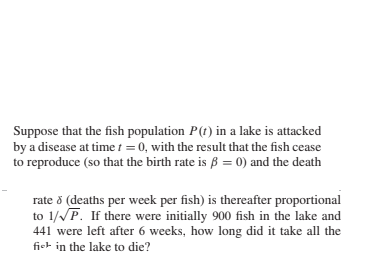Suppose that the fish population P(t) in a lake is attacked by a disease at time t = 0, with the result that the fish cease to reproduce (so that the birth rate is ß = 0) and the death rate 8 (deaths per week per fish) is thereafter proportional to 1/P. If there were initially 900 fish in the lake and 441 were left after 6 weeks, how long did it take all the fiet in the lake to die?
Suppose that the fish population P(t) in a lake is attacked by a disease at time t = 0, with the result that the fish cease to reproduce (so that the birth rate is ß = 0) and the death rate 8 (deaths per week per fish) is thereafter proportional to 1/P. If there were initially 900 fish in the lake and 441 were left after 6 weeks, how long did it take all the fiet in the lake to die?
Algebra & Trigonometry with Analytic Geometry
13th Edition
ISBN:9781133382119
Author:Swokowski
Publisher:Swokowski
Chapter5: Inverse, Exponential, And Logarithmic Functions
Section: Chapter Questions
Problem 15T
Related questions
Question

Transcribed Image Text:Suppose that the fish population P(t) in a lake is attacked
by a disease at time t = 0, with the result that the fish cease
to reproduce (so that the birth rate is ß = 0) and the death
rate 8 (deaths per week per fish) is thereafter proportional
to 1/P. If there were initially 900 fish in the lake and
441 were left after 6 weeks, how long did it take all the
fiet in the lake to die?
Expert Solution
This question has been solved!
Explore an expertly crafted, step-by-step solution for a thorough understanding of key concepts.
This is a popular solution!
Trending now
This is a popular solution!
Step by step
Solved in 4 steps with 4 images

Recommended textbooks for you

Algebra & Trigonometry with Analytic Geometry
Algebra
ISBN:
9781133382119
Author:
Swokowski
Publisher:
Cengage


Algebra & Trigonometry with Analytic Geometry
Algebra
ISBN:
9781133382119
Author:
Swokowski
Publisher:
Cengage
